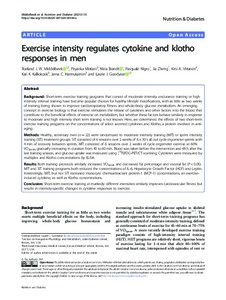Exercise intensity regulates cytokine and klotho responses in men
Middelbeek Roeland JW; Nigro Pasquale; Goodyear Laurie J; Zheng Jia; Kalliokoski Kari K; Motiani Piryanka; Virtanen Kirsi A; Hannukainen Jarna C; Brandt Nina
Exercise intensity regulates cytokine and klotho responses in men
Middelbeek Roeland JW
Nigro Pasquale
Goodyear Laurie J
Zheng Jia
Kalliokoski Kari K
Motiani Piryanka
Virtanen Kirsi A
Hannukainen Jarna C
Brandt Nina
SPRINGERNATURE
Julkaisun pysyvä osoite on:
https://urn.fi/URN:NBN:fi-fe2021042824018
https://urn.fi/URN:NBN:fi-fe2021042824018
Tiivistelmä
Background
Short-term exercise training programs that consist of moderate intensity endurance training or high intensity interval training have become popular choices for healthy lifestyle modifications, with as little as two weeks of training being shown to improve cardiorespiratory fitness and whole-body glucose metabolism. An emerging concept in exercise biology is that exercise stimulates the release of cytokines and other factors into the blood that contribute to the beneficial effects of exercise on metabolism, but whether these factors behave similarly in response to moderate and high intensity short term training is not known. Here, we determined the effects of two short-term exercise training programs on the concentrations of select secreted cytokines and Klotho, a protein involved in anti-aging.
Methods
Healthy, sedentary men (n = 22) were randomized to moderate intensity training (MIT) or sprint intensity training (SIT) treatment groups. SIT consisted of 6 sessions over 2 weeks of 6 x 30 s all out cycle ergometer sprints with 4 min of recovery between sprints. MIT consisted of 6 sessions over 2 weeks of cycle ergometer exercise at 60% VO2peak, gradually increasing in duration from 40 to 60 min. Blood was taken before the intervention and 48 h after the last training session, and glucose uptake was measured using [18F]FDG-PET/CT scanning. Cytokines were measured by multiplex and Klotho concentrations by ELISA.
Results
Both training protocols similarly increased VO2peak and decreased fat percentage and visceral fat (P < 0.05). MIT and SIT training programs both reduced the concentrations of IL-6, Hepatocyte Growth Factor (HGF) and Leptin. Interestingly, MIT, but not SIT increased monocyte chemoattractant protein-1 (MCP-1) concentrations, an exercise-induced cytokine, as well as Klotho concentrations.
Conclusion
Short-term exercise training at markedly different intensities similarly improves cardiovascular fitness but results in intensity-specific changes in cytokine responses to exercise.
Kokoelmat
- Rinnakkaistallenteet [19218]
